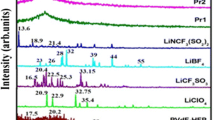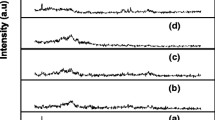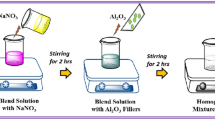Abstract
This paper reports on preparation and characterization of thin films of a new zinc ion conducting blended polymer electrolyte system containing polyethylene oxide [PEO] and polypropylene glycol [PPG] complexed with zinc triflate [Zn(CF3SO3)2] salt. The room temperature ionic conductivity (σ 298K) data of such PEO-PPG polymer blends prepared by solution casting technique were found to be of the order of 10−5 S cm−1, whereas the optimized composition containing 90:10 wt% ratio of PEO and PPG possessed an appreciably high ionic conductivity of 7.5 × 10−5 S cm−1. Subsequently, six different weight percentages of zinc triflate viz., 2.5, 5, 7.5, 10, 12.5 and 15, respectively, were added into the above polymer blend and resulting polymer-salt complexes were characterized by means of various analytical tools. Interestingly, the best conducting specimen namely 87.5 wt% (PEO:PPG)-12.5 wt% Zn(CF3SO3)2 exhibited an enhanced room temperature ionic conductivity of 6.9 × 10−4 S cm−1 with an activation energy of 0.6 eV for ionic conduction. The present XRD results have indicated the occurrence of characteristic PEO peaks and effects of salt concentration on the observed intensity of these diffraction peaks. Appropriate values of degree of crystallinity for different samples were derived from both XRD and DSC analyses, while an examination of surface morphology of the blended polymer electrolyte system has revealed the formation of homogenous spherulites involving a rough surface and relevant zinc ionic transport number was found to be 0.59 at room temperature for the best conducting polymer electrolyte system thus developed.








Similar content being viewed by others
References
Mohapatra SR, Thakur AK, Choudhary RNP (2009) Effect of nanoscopic confinement on improvement in ion conduction and stability properties of an intercalated polymer nanocomposite electrolyte for energy storage applications. J Power Sources 191:601–613. doi:10.1016/j.jpowsour.2009.01.100
Sengwa RJ, Dhatarwal P, Choudhary S (2014) Role of preparation methods on the structural and dielectric properties of plasticized polymer blend electrolytes: correlation between ionic conductivity and dielectric parameters. Electrochim Acta 142:359–370. doi:10.1016/j.electacta.2014.07.120
Agrawal RC, Pandey GP (2008) Solid polymer electrolytes: material designing and all-solid-state battery applications: an overview. J Phys D Appl Phys 41:223001. doi:10.1088/0022-3727/41/22/223001
Syzdek J, Armand M, Marcinek M, Zalewska A, ˙Zukowska G, Wieczorek W (2010) Detailed studies on the fillers modification and their influence on composite, poly(oxyethylene)-based polymeric electrolytes. Electrochim Acta 55:1314–1322. doi:10.1016/j.electacta.2009.04.025
Choudhary S, Sengwa RJ (2013) Effects of preparation methods on structure, ionic conductivity and dielectric relaxation of solid polymeric electrolytes. Mater Chem Phys 142:172–181. doi:10.1016/j.matchemphys.2013.06.053
Reddeppa N, Sharma AK, Rao VVRN, Chen W (2014) AC conduction mechanism and battery discharge characteristics of (PVC/PEO) polyblend films complexed with potassium chloride. Measurement 47:33–41. doi:10.1016/j.measurement.2013.08.047
Sim LH, Gan SN, Chan CH, Yahya R (2010) ATR-FTIR studies on ion interaction of lithium perchlorate in polyacrylate/poly(ethylene oxide) blends. Spectrochim Acta A 76:287–292. doi:10.1016/j.saa.2009.09.031
Caramia V, Bayer SI, Anyfantis GC, Ruffilli R, Ayadi F, Martiradonna L, Cingolani R, Athanassiou A (2013) Tailoring the morphology of poly(ethylene oxide)/silver triflate blends: from crystalline to self-assembled nanofibrillar structures. Nanotechnology 24:055602. doi:10.1088/0957-4484/24/5/055602
Borkowska R, Laskowski J, Plocharski J, Przyluski J, Wieczorek W (1993) Performance of acrylate-poly(ethylene oxide) polymer electrolytes in lithium batteries. J Appl Electrochem 23:991
Wieczorek W, Stevens JR (1997) Impedance spectroscopy and phase structure of polyether-poly(methyl methacrylate)-LiCF3SO3 blend-based electrolytes. J Phys Chem B 101:1529–1534. doi:10.1021/jp962517w
Song JY, Wang YY, Wan CC (1999) Review of gel-type polymer electrolytes for lithium-ion batteries. J Power Sources 77:183–197. doi:10.1016/S0378-7753(98)00193-1
Johan MR, Shy OH, Ibrahim S, Yassin SMM, Hui TY (2011) Effects of Al2O3 nanofiller and EC plasticizer on the ionic conductivity enhancement of solid PEO–LiCF3SO3 solid polymer electrolyte. Solid State Ionics 196:41–47. doi:10.1016/j.ssi.2011.06.001
Jacob MME, Prabaharan SRS, Radhakrishna S (1997) Effect of PEO addition on the electrolytic and thermal properties of PVDFLiClO4 polymer electrolytes. Solid State Ionics 104:267–276
Radhakrishnan S, Venkatachalapathy PD (1996) Effect of casting solvent on the crystallization in PEO/PMMA blends. Polymer 37:3749–3752. doi:10.1016/0032-3861(96)00192-9
Sekhar PC, Kumar PN, Sharma AK (2012) Effect of plasticizer on conductivity and cell parameters of (PMMA + NaClO4) polymer electrolyte system. J Appl Phys 2:01–06. doi:10.9790/4861-0240106
Rand DAJ (1979) Battery systems for electric vehicles—a state-of-the-art review. J Power Sources 4:101–143. doi:10.1016/0378-7753(79)85001-6
Kumar M, Sekhon SS (2002) Role of plasticizer’s dielectric constant on conductivity modification of PEO–NH4F polymer electrolytes. Eur Polym J 38:1297–1304. doi:10.1016/S0014-3057(01)00310-X
Kang MS, Kim JH, Kim YJ, Won J, Park NG, Kang YS (2004) Dye-sensitized solar cells based on composite solid polymer electrolytes. Chem Commun 889-891. doi: 10.1039/B412129P
Paulmer RDA, Kulkarni AR (1994) Synthesis and conductivity behavior of ternary PEO-PPG-NaClO4 amorphous blends. Solid State Ionics 68:243–247. doi:10.1016/0167-2738(94)90182-1
Kumar GG, Sampath S (2004) Spectroscopic characterization of a gel polymer electrolyte of zinc triflate and polyacrylonitrile. Polymer 45:2889–2895. doi:10.1016/j.polymer.2004.02.053
Sownthari K, Suthanthiraraj SA (2014) Preparation and properties of a gel polymer electrolyte system based on poly-ε-caprolactonecontaining1-ethyl-3-methylimidazolium bis (trifluoromethylsulfonyl)imide. J Phys Chem Solids 75:746–751. doi:10.1016/j.jpcs.2014.02.003
Narayanan NSV, Ashokraj BV, Sampath S (2010) Ambient temperature, zinc ion-conducting, binary molten electrolyte based on acetamide and zinc perchlorate: application in rechargeable zinc batteries. J Colloid Interface Sci 342:505–512. doi:10.1016/j.jcis.2009.10.034
Tao R, Zhao Y, Fujinami T (2007) Lithium borate–PEO polymer electrolytes characterized with high lithium ion transference numbers. Mater Sci Eng B 137:69–73. doi:10.1016/j.mseb.2006.10.010
Watanabe M, Tokuda H, Muto S (2001) Anionic effect on ion transport properties in network polyether electrolytes. Electrochim Acta 46:1487–1491. doi:10.1016/S0013-4686(00)00743-X
Ciosek M, Sannier L, Siekierski M, Golodnitsky D, Peled E, Scrosati B, Głowinkowski S, Wieczorek W (2007) Ion transport phenomena in polymeric electrolytes. Electrochim Acta 53:1409–1416. doi:10.1016/j.electacta.2007.03.037
Fan F (2015) Ion transport in polymer electrolytes. PhD dissertation, University of Tennessee
Zainol NH, Samin SM, Othman L, Isa KBM, Chong WG, Osman Z (2013) Magnesium ion-based gel polymer electrolytes: ionic conduction and infrared spectroscopy studies. Int J Electrochem Sci 8:3602–3614
Evans J, Colin VA, Bruce PG (1987) Electrochemical measurement of transference numbers in polymer electrolytes. Polymer 28:2324–2328. doi:10.1016/0032-3861(87)90394-6
Guinier A (1994) X-ray diffraction in crystals, imperfect crystals and amorphous bodies. Dover Publications, New York
Hyun J (2001) A new approach to characterize crystallinity by observing the mobility of plasma treated polymer surfaces. Polymer 42:6473–6477. doi:10.1016/S0032-3861(01)00116-1
Dey A, Karan S, De SK (2010) Molecular interaction and ionic conductivity of polyethylene oxide–LiClO4 nanocomposites. J Phys Chem Solids 71:329–335
Booth C, Pickles CJ (1973) Phase separation in mixtures of poly(ethylene oxide) and poly(propylene oxide). J Polym Sci B Polym Phys 11:595. doi:10.1002/pol.1973.180110316
Sownthari K, Suthanthiraraj SA (2015) Preparation and properties of biodegradable polymer-layered silicate nanocomposite electrolytes for zinc based batteries. Electrochim Acta 174:885–892. doi:10.1016/j.electacta.2015.06.049
Guisao JPT, Romero AJF (2015) Interaction between Zn2+ cations and n-methyl-2-pyrrolidone in ionic liquid-based gel polymer electrolytes for Zn batteries. Electrochim Acta 176:1447–1453. doi:10.1016/j.electacta.2015.07.132
Prasanna CMS, Suthanthiraraj SA (2015) Electrical, structural, and morphological studies of honeycomb-like microporous zinc-ion conducting poly (vinyl chloride)/poly (ethyl methacrylate) blend-based polymer electrolytes. Ionics. doi:10.1007/s11581-015-1546-4
Armand MB, Chabagno JM, Duclot MJ, Vashista P, Mundy JN, Shenoy GK (1979) Fast ion transport in solids, North Holland, p. 131
Souquet JL, Lévy M, Duclot M (1994) A single microscopic approach for ionic transport in glassy and polymer electrolytes. Solid State Ionics 70/71:337. doi:10.1016/0167-2738(94)90333-6
Fan F, Wang Y, Sokolov AP (2013) Ionic transport, micro-phase separation, and polymer relaxation in poly(propylene glycol) and lithium perchlorate mixtures. Macromolecules 46:9380–9389. doi:10.1021/ma401238k
Hodge RM, Edward GH, Simon GP (1996) Water absorption and states of water in semi crystalline poly(vinyl alcohol) films. Polymer 37:1371–1376. doi:10.1016/0032-3861(96)81134-7
Amudha S, Suthanthiraraj SA (2015) Silver ion conducting characteristics of a polyethylene oxide-based composite polymer electrolyte and application in solid state batteries. Adv Mater Lett 6(10):874–882. doi:10.5185/amlett.2015.5831
Akhtar MS, Kim UY, Choi DJ, Yang OB (2010) Effect of electron beam irradiation on the properties of polyethylene oxide–TiO2 composite electrolyte for dye sensitized solar cells. Mater Sci Forum 658:161–164. doi:10.4028/www.scientific.net/MSF.658.161
Vignarooban K, Dissanayake MAKL, Albinsson I, Mellander BE (2015) Ionic conductivity enhancement in PEO:CuSCN solid polymer electrolyte by the incorporation of nickel-chloride. Solid State Ionics 278:177–180. doi:10.1016/j.ssi.2015.06.014
Ulaganathan M, Nithya R, Rajendran S, in: Viacheslav Kazmiruk (Ed.), (2012) Scanning electron microscopy, ISBN: 978-953-51-0092-8, InTech 671-694
Chu PP, Reddy MJ, Kao HM (2003) Novel composite polymer electrolyte comprising mesoporous structured SiO2 and PEO/Li. Solid State Ionics 156:141. doi:10.1016/S0167-2738(02)00582-9
Suthanthiraraj SA, Vadivel MK (2012) Effect of propylene carbonate as a plasticizer on (PEO)50AgCF3SO3:SnO2 nanocomposite polymer electrolyte. Appl Nanosci 2:239. doi:10.1007/s13204-012-0099-3
Yap YL, You AH, Teo LL, Hanapei H (2013) Inorganic filler sizes effect on ionic conductivity in polyethylene oxide (PEO) composite polymer electrolyte. Int J Electrochem Sci 8:2154–2163
Acknowledgments
We acknowledge the characterization facility provided for FESEM analysis by the National Centre for Nanoscience and Nanotechnology, University of Madras.
Author information
Authors and Affiliations
Corresponding author
Rights and permissions
About this article
Cite this article
Nancy, A.C., Suthanthiraraj, S.A. Preparation and characterization of a new PEO-PPG blend polymer electrolyte system. Ionics 22, 2399–2408 (2016). https://doi.org/10.1007/s11581-016-1767-1
Received:
Revised:
Accepted:
Published:
Issue Date:
DOI: https://doi.org/10.1007/s11581-016-1767-1




